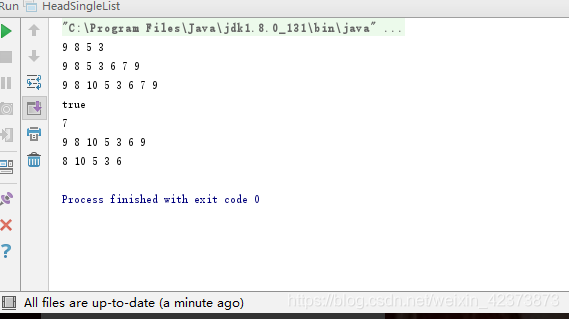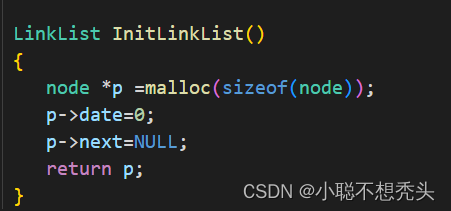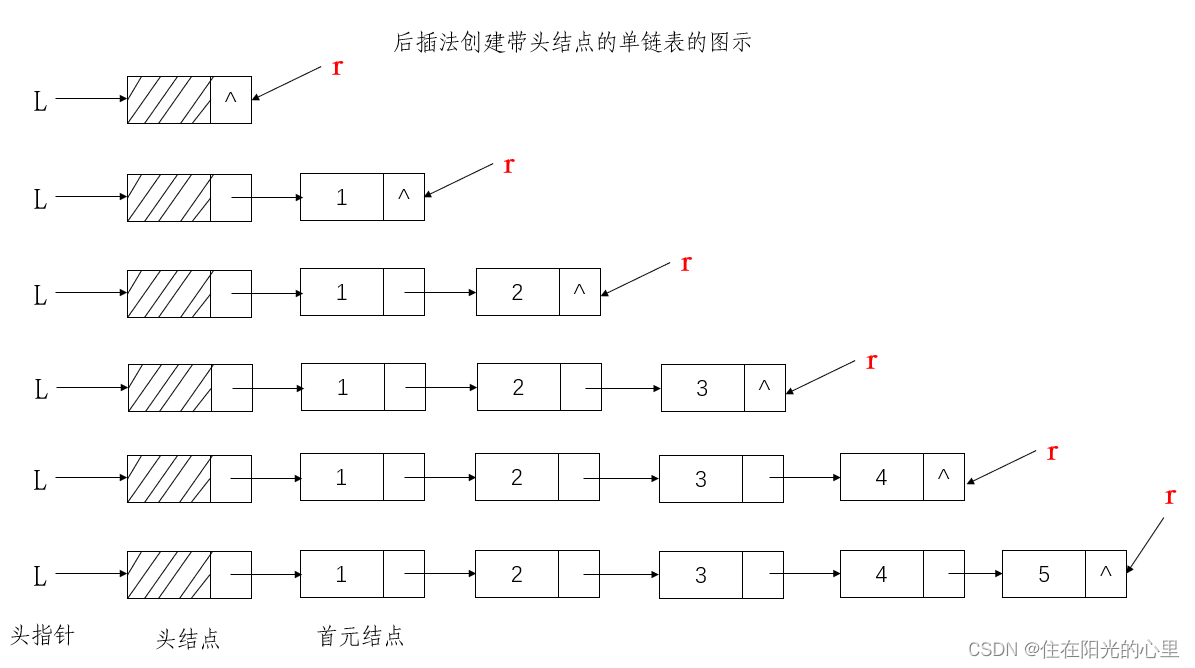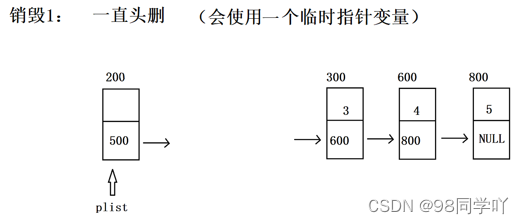
单链表分为:带头结点和不带头结点,不带头结点的单链表需要用到二级指针,容易出错。

1、结构体设计
typedef int ELEM_TYPE; //有效数据节点结构体设计(头结点借用)
typedef struct Node
{ELEM_TYPE data;//数据域 (1.头结点:不保存任何数据 2.有效数据节点:保存有效值) struct Node *next;//指针域 (1.头结点:保存第一个元素的地址 2.有效数据节点:保存下一个有效元素的地址)
}Node, PNode;
2、带头结点的单链表的基本操作
(1)初始化、购买新节点
//初始化函数(对于头结点进行赋初值)
void Init_list(struct Node *plist)
{assert(plist != NULL);if(NULL == plist){return;}//plist->data; 头结点的数据域不需要赋值plist->next = NULL;
}//购买一个新节点
struct Node *BuyNode(ELEM_TYPE val)
{struct Node*pnewnode = (struct Node*)malloc(1 * sizeof(struct Node));assert(pnewnode != NULL);if(pnewnode == NULL){return NULL;}pnewnode->data = val;pnewnode->next = NULL; return pnewnode;
}
(2)头插

//头插
bool Insert_head(struct Node *plist, ELEM_TYPE val)
{//1.判断参数合法性assert(plist != NULL);if(NULL == plist){return false;}//2.1申请新节点 (插入一个节点, malloc申请一个节点)struct Node*pnewnode = (struct Node*)malloc(1 * sizeof(struct Node));assert(pnewnode != NULL);if(pnewnode == NULL){return false;}//2.2将val值赋值给新节点pnewnode->data = val;//pnewnode->next = NULL; //?//3.找到合适的插入位置 (因为是头插函数, 所以直接可以得到合适的插入位置)//4.插入pnewnode->next = plist->next;//因为plist的next域指向首元素地址plist->next = pnewnode;return true;
}(3)尾插

//尾插
bool Insert_tail(struct Node *plist, ELEM_TYPE val)
{//assert//1.购买新节点struct Node * pnewnode = BuyNode(val);assert(pnewnode != NULL);if(NULL == pnewnode){return false;}//2.找到合适的插入位置struct Node *p = plist;//因为指针p在for循环外面,还要使用,所以定义在for外面for(p; p->next!=NULL; p=p->next);//此时p指向尾结点//3.插入pnewnode->next = p->next; //pnewnode->next = NULL;p->next = pnewnode;return true;
}(4)按位置插入

//按位置插入(pos=0 相当于头插 pos==length 相当于尾插)
bool Insert_pos(struct Node *plist, int pos, ELEM_TYPE val)
{assert(plist != NULL);assert(pos >=0 && pos<=Get_length(plist));//1.购买新节点struct Node * pnewnode = BuyNode(val);assert(pnewnode != NULL);if(NULL == pnewnode){return false;}//2.找到合适的插入位置 struct Node *p = plist; for(int i=0; i<pos; i++){p=p->next;}//3.插入pnewnode->next = p->next;p->next = pnewnode;return true;
}
(5)头删

//头删
bool Del_head(struct Node *plist)
{//assertif(IsEmpty(plist))//删除需要判空return false;struct Node *p = plist->next;plist->next = p->next;//plist->next = plist->next->next;free(p);return true;
}
(6)尾删

//尾删
bool Del_tail(struct Node *plist)
{//assertif(IsEmpty(plist)) //删除需要判空return false;struct Node *p = plist;for(p; p->next!=NULL; p=p->next); // 此时p指向尾结点struct Node *q = plist;for(q; q->next!=p; q=q->next); // 此时q停在尾结点的前面q->next = p->next;//q->next = NULL;free(p);return true;
}(7)按位置删
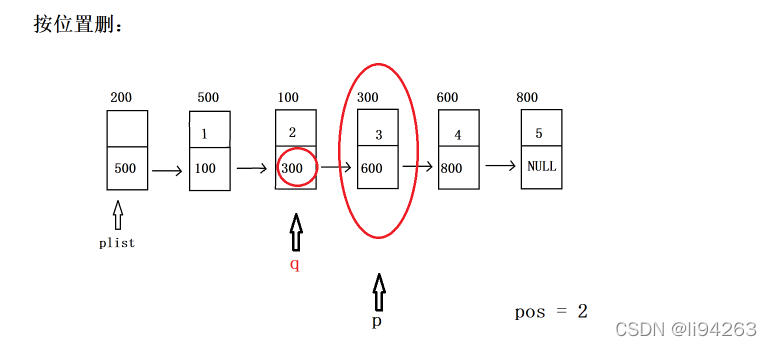
//按位置删(pos==0 相当于头删 pos==length-1 相当于尾删(pos==length非法))
bool Del_pos(struct Node *plist, int pos)
{assert(plist != NULL);assert(pos >=0 && pos<Get_length(plist));//length这个位置 可以插不能删if(IsEmpty(plist)) //删除需要判空return false;/*struct Node *p = plist;for(int i=0; i<=pos; i++){p=p->next;}*/struct Node *q = plist;for(int i=0; i<pos; i++){q=q->next;}struct Node *p = q->next;q->next = p->next;free(p);return true;
}
(8)按值删
//按值删
bool Del_val(struct Node *plist, ELEM_TYPE val)
{//assertstruct Node *p = Search(plist, val);if(p == NULL){return false;}struct Node *q = plist;for(q; q->next!=p; q=q->next);//q在待删除节点p的前面q->next = p->next;free(p);return true;
}
(9)获取值位置
//获取值位置 (如果val值存在, 则返回其地址 不然返回NULL)
struct Node* Search(struct Node *plist, ELEM_TYPE val)
{//assertfor(struct Node *p = plist->next; p!=NULL; p=p->next){if(p->data == val){return p;}}return NULL;
}
(10)判空、判满、有效长度、情空、销毁、打印
//判空
bool IsEmpty(struct Node *plist)
{//assertreturn plist->next == NULL;
}//获取单链表有效数据节点个数
int Get_length(struct Node *plist)
{//assertint count = 0;for(struct Node *p=plist->next; p!=NULL; p=p->next){count++;}return count;
}//清空 相当于直接调用销毁
void Clear(struct Node *plist)
{Destroy(plist);
}//销毁1(malloc申请来的空间 全部释放掉)
void Destroy(struct Node *plist)
{//assert//一直循环判断(判断单链表里还有没有节点,如果有,则头删一次)/*while(!IsEmpty(plist)){Del_head(plist);}plist->next = NULL;*/while(plist->next != NULL){struct Node *p = plist->next;plist->next = p->next;free(p);}plist->next = NULL;
}//销毁2
void Destroy2(struct Node *plist)
{//assertstruct Node *p = plist->next;struct Node *q = NULL;//q先不要赋值为p->next 因为p有可能指向NULL plist->next = NULL;//接下来 就和我头结点没有任何关系了while(p != NULL){q = p->next;free(p);p = q;}
}//打印
void Show(struct Node *plist)
{for(struct Node *p=plist->next; p!=NULL; p=p->next){printf("%d ", p->data);}printf("\n");
}3、主函数测试
int main()
{struct Node head;Init_list(&head);for(int i=0; i<20; i++){Insert_pos(&head, i, i+1);}Show(&head);Insert_head(&head, 100);Insert_tail(&head, 200);Show(&head);printf("length = %d\n", Get_length(&head));Del_head(&head);Del_tail(&head);Show(&head);Del_pos(&head, 4);Del_val(&head, 14);Show(&head);printf("length = %d\n", Get_length(&head));//Destroy(&head);Destroy2(&head);//printf("%d\n", sizeof(struct Node));return 0;
}
